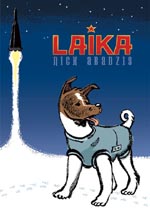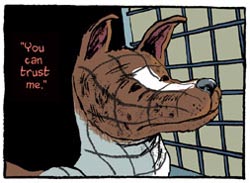 By Nick Abadzis
By Nick Abadzis
208 pages, color
Published by First Second Books
You can know the ending to a book and, if it’s well crafted, still enjoy the experience. That’s absolutely the case with Nick Abadzis’s Laika, his telling of the dog sent into orbit inside Sputnik 2 in 1957. People who are even remotely familiar with Laika’s place in history know the ultimate fate of her and the Sputnik 2 mission, but that’s not the important thing. Here, it’s about how Abadzis tells Laika’s story that will keep you intrigued as a reader, and ultimately feel sadness for a brave little dog.
As a puppy, Laika was given to a young boy to teach him responsibility—but all it really taught him was how to hate owning a dog. At the same time, a program director once imprisoned for treason is given an impossible deadline for a new space mission. The two make history, but in a way that with hindsight is more than regrettable.
 While historically accurate, much of the first quarter of Laika comes entirely from Abadzis’s imagination; there’s no way to know what Laika’s life was like before given to the Institution of Aviation Medicine, being a stray dog on the streets of Moscow. What he creates is the sort of story that can’t help but pull on your heartstrings; it’s emotionally manipulative in putting Laika through hard times as a puppy, letting her survive difficult odds over and over again. Because Abadzis’s only plot restriction is eventually getting Laika to the dog catcher, he’s able to spend that time making sure that the reader will care about the little dog. It works with the greatest of ease; by the time Dr. Oleg Gazenko takes custody of Laika, you desperately want her to succeed.
While historically accurate, much of the first quarter of Laika comes entirely from Abadzis’s imagination; there’s no way to know what Laika’s life was like before given to the Institution of Aviation Medicine, being a stray dog on the streets of Moscow. What he creates is the sort of story that can’t help but pull on your heartstrings; it’s emotionally manipulative in putting Laika through hard times as a puppy, letting her survive difficult odds over and over again. Because Abadzis’s only plot restriction is eventually getting Laika to the dog catcher, he’s able to spend that time making sure that the reader will care about the little dog. It works with the greatest of ease; by the time Dr. Oleg Gazenko takes custody of Laika, you desperately want her to succeed.
The human element of Laika is an interesting one, because it’s there that the book both really succeeds as well as has its only stumbling block. Reading about Yelena Dubrovsky and Dr. Gazenko’s relationship with both each other as well as the dogs is a perfect addition to the story. It gives a real human reaction to the experiments and tests at the Institution, especially through Yelena and her vocalizing what the reader may have been thinking. Abadzis is also able to use Yelena’s relationship with Laika and the other dogs to give them a voice of their own; while in other hands the idea of Yelena imagining what the dogs are thinking could fail, here it succeeds because it’s as much Yelena’s own misgivings projected onto the dogs as it is their feelings brought to life. On the other hand, the one major character that I was never able to really warm to was Chief Designer Sergei Korolev. While his work and story is an integral part of the full Sputnik 2 story, he never seemed to quite fit. It’s strange, because some of the sequences involving him, such as his telling Laika about his imprisonment, are wonderfully drawn and presented. For a book with her name as the title, though, Laika is ultimately Laika’s tale, and anyone else is just second best.
 Abadzis’s art in Laika is really nice, drawing Laika so much like her real life counterpart while still keeping his own slightly cartoonish style. The view of Laika gazing out of her cage is perfect, with so many emotions able to be read into her expression. For a book that depends on a dog being drawn well, Abadzis absolutely has the chops to pull it off. He’s good at the rest of the book as well, though. Sequences with Sergei talking about his past as a prisoner use a good combination of negative space and fully drawn scenes to get the right ideas across, for example, and Laika’s dream of flying over the world is one of the most beautiful images in the entire book.
Abadzis’s art in Laika is really nice, drawing Laika so much like her real life counterpart while still keeping his own slightly cartoonish style. The view of Laika gazing out of her cage is perfect, with so many emotions able to be read into her expression. For a book that depends on a dog being drawn well, Abadzis absolutely has the chops to pull it off. He’s good at the rest of the book as well, though. Sequences with Sergei talking about his past as a prisoner use a good combination of negative space and fully drawn scenes to get the right ideas across, for example, and Laika’s dream of flying over the world is one of the most beautiful images in the entire book.
Abadzis’s mixing of fact and fiction in Laika ends in a gorgeously created book. It’s heartbreaking, knowing what will ultimately happen to Laika, but at the same time it’s immensely compelling reading. For a mute protagonist whose own thoughts are limited to echoes of dialogue from other characters, Laika is the sort of character that makes you feel both sympathy and pride for her travails. Reading Laika is the sort of experience that you won’t forget any time soon. Laika is scheduled for release in September 2007; if you’re pre-ordering through a comic book store, you can tell them that the book has Diamond order code JUL07 3580.
Purchase Links: Amazon.com
